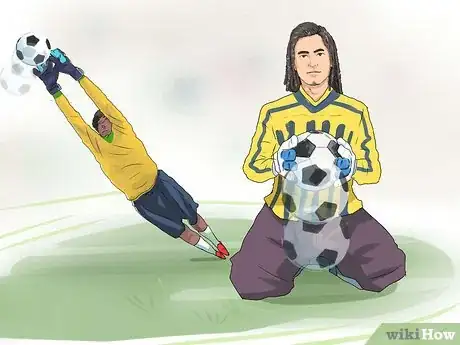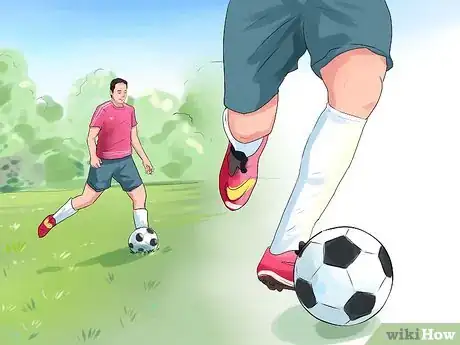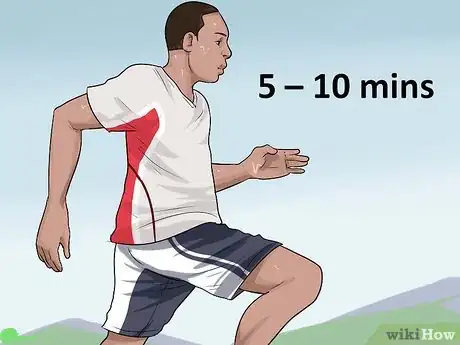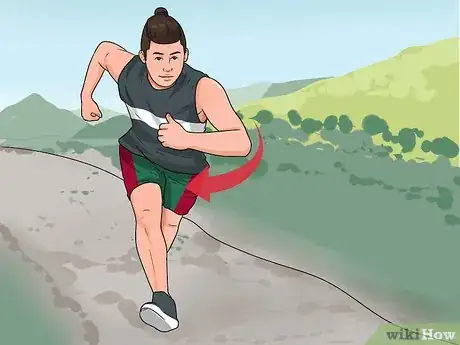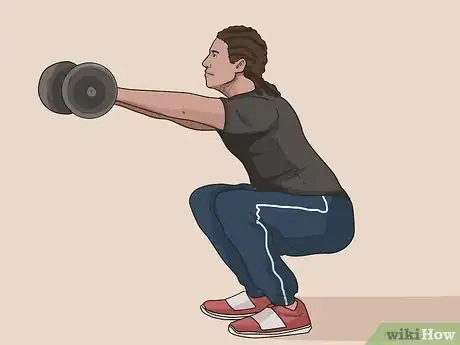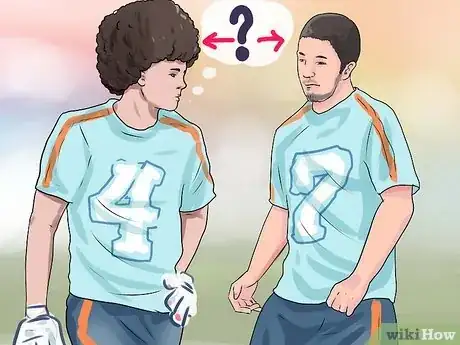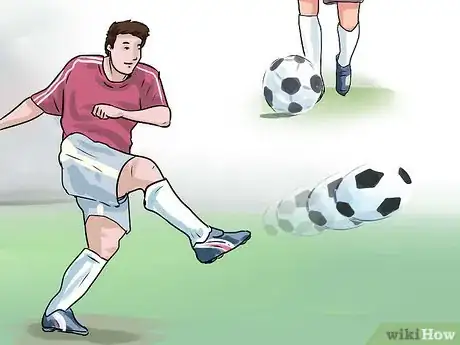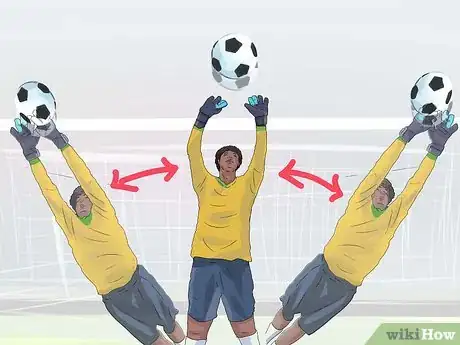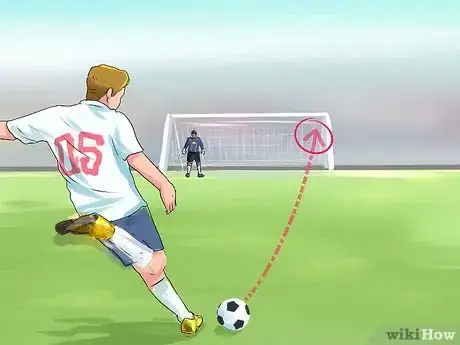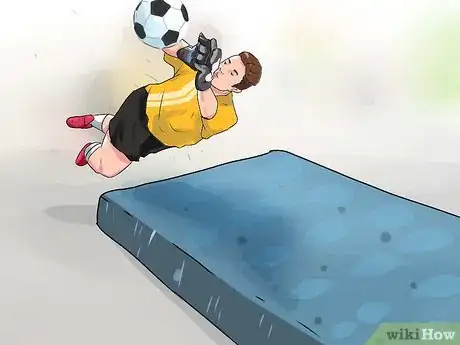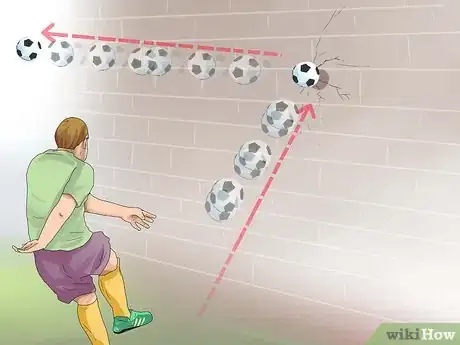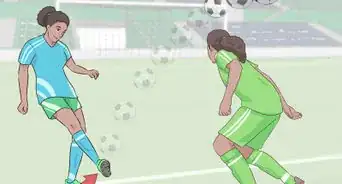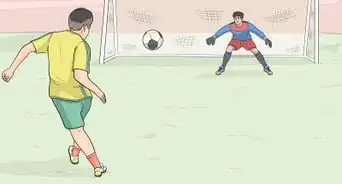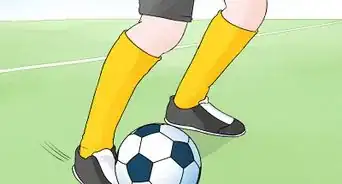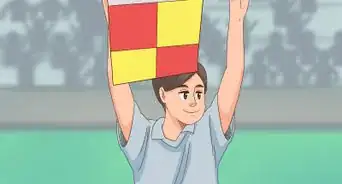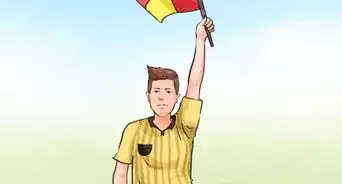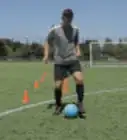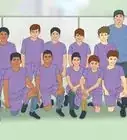This article was co-authored by Francisco Gomez. Francisco Gomez is the Head Coach at the FIT Potato Gym, a training gym established in 2001 in the San Francisco Bay Area. Francisco is a former competitive runner who helps endurance athletes train for major marathons like the Boston Marathon. Francisco specializes in Injury Rehab, Flexibility, Marathon Training, and Senior Fitness. He has a B.S. in Nutrition and Exercise Physiology & Running.
wikiHow marks an article as reader-approved once it receives enough positive feedback. In this case, 82% of readers who voted found the article helpful, earning it our reader-approved status.
This article has been viewed 121,896 times.
Soccer is one of the most popular sports in the world. Millions of people enjoy watching soccer and millions love playing it. But training for soccer, which is free-flowing and played with only one rest break, is not as simple as running for long distances 2-3 times a week. Different positions can gain different things from their workout, and should learn how to best train for soccer to become the best players.
Steps
Improving Fitness and Conditioning
-
1Train for your position to get the most out of your fitness. Different soccer players have different training needs to be successful. A goalie, after all, doesn't need to be able to run for as long as a center midfielder. But even similar positions, like outside defenders and midfielders, can focus on slightly different training regimens:
- Goalies: Need quick, powerful reactions and very little long-distance stamina. Focus on strength, reactions, and a slim, quick figure.
- Defenders: Need upper/lower body strength and sprinting speed. Rarely required to jog or run for long, continuous times, they need to be able to get to every ball and win it in the air or on the ground.
- Midfielders: Need to be able to run for days. They should have exceptional stamina and above-average speed. Quickness and strong foot skills are a must.
- Forwards: Need a balance of speed and strength, like defenders, but must also be able to jog for days to confuse defenders and open up offensive space.
-
2Play games and scrimmages to train your whole body at once. The best way to get in soccer shape is to play soccer. While you will need to work on additional training as well, games force you to work on endurance, strength, speed, and agility in real-life situations. As long as you're exhausted at the end of the game, you've gotten a good training session in.
- When playing games for fun, move around and play multiple positions. This will help you learn the game and build full-body fitness.
Advertisement -
3Replace the majority of long distance runs with interval training. Interval training is when you alternate hard sprints or effort with short rest periods, teaching your body to get to top speed and recover your energy quickly.[1] It is much more game-realistic than an hour of jogging, and is proven to get faster results.[2] A sample workout might look like this (note that there is no "rest" period. Jogging is your rest).
- Jog for 5-10 minutes to warm up.
- Sprint for 30 seconds.
- Jog for 1 minute (1:30 if struggling)
- Alternate sprinting/jogging for 9 more sprints.
- Jog for 5-10 minutes to cool down.
- Lower the rest period as you get better, eventually aiming for a 30-second sprint and jog.
-
4Build agility and reaction speed with plyometrics and direction changing workouts. Being quick on your feet is essential to becoming a killer player. There are endless exercises to try, but some classics include:
- Cone Runs: Stagger the cones in a zig-zag, then run the course, focusing on sharp turns around each cone.
- Suicides: Create 2 lines roughly 20 yards apart. Sprint to the end, touch the line, and sprint back. Focus on maintaining speed and balance as you change directions as quickly and smoothly as possible.
- Ladder drills: Focus on light, fast feet. Make up different patterns to train agility -- both feet in each hole, down and back, sideways, etc.
- Hurdles or Box Jumps: Focus on landing on your toes and springing back up quickly and efficiently.[3] You want to land, compress, and shoot back up quickly, as if winning a header.
-
5Recover and build endurance with long distance runs and endurance activities. Do these workouts 1-2 a week. A long, slow run is not a great way to train for soccer on its own, but it still has a place in your workout to help you build stamina.[4] Use it on off days to move and stretch your muscles when you can't fully work out. Swim and bike to activate different muscles and give your joints a rest from the pounding of constant running. No matter what your style, aim for a simple, easy pace and try to run for at least 30 minutes to an hour.
-
6Build your upper body to improve your game play. A strong upper body helps you fight defenders, win headers, and become a harder player to tackle. Full-body strength allows you to fight hard for loose balls, resist tackles, and muscle for position on crosses and clears. Soccer players want to stay lean, but still strong, and light strength training will make you a formidable opponent anywhere on the field. Work on the following muscle groups 2-4 times a week, choosing 2-3 exercises for each group.
- Chest and Back: Your chest and back muscles will help you create and keep space in the box or in the air. A strong back, furthermore, increases balance on the ball and overall strength.
- Tone your arms: Bicep curls, dips, tricep push-ups (your hands form a diamond under your chest), and pull-ups all build solid muscle from home. Toning your arms helps push away defenders and attackers and keep balance on the ball.[5]
- Abs and Core: Sit-ups, crunches, and planks are an essential part of your workout, and can be performed daily. You transfer power between you upper and lower body through your core -- any crosses, shots, long passes, or headers require rock-solid muscles.
-
7Push yourself as hard as you can in practices, scrimmages, and drills. This helps you get "match fitness." You will have to do dedicated fitness to truly train for soccer. That said, the fastest way to get to match fitness is to actually push yourself as if you were in a match. Whenever you do drills or play games, work until you're exhausted. It is far more fun than doing sprints later on to get strong, and far more game realistic.[6]
- When you're tired, focus the most on your foot skills. The players that stay technically proficient even when they get tired are the ones that win last-minute games.
- Training in practice ensures you're training for your specific position. Even in pick-up games or scrimmages, the only way you get better is by working hard.
- Having a dedicated training partner can help ensure you always work hard, and a little bit of competition is great motivation.
Training Ball Skills
-
1Work on your close ball control with juggling and drills. Control is a very important part of soccer. The best way to practice control is to juggle and practice dribbling a ball. Keep the ball as close to your body as possible and try to get as many touches on the ball as you can to keep the ball under control.
- Juggling: Use your whole body (other than arms and hands) to keep the ball from hitting the ground. How many touches can you get?
- Cone Workouts: Set up a pattern of cones, then dribble through them as fast as you can without touching a cone. If you touch a cone, you have to do another lap.
- Close Touch Drills: Bounce the ball between your feet quickly. Leave the ball in place and toe tap it with each foot rapidly, rolling it slightly under your sole. Roll ball to either side of you, then chop it back to the other foot. Basically, use every part of your foot to practice keeping the ball close.[7]
-
2Look up when you dribble, not at the ball. The more of the field you can see as you dribble, the better you next pass, move, or shot will be. Focus on keeping your head up at all times when dribbling to greatly increase your touch and your skills.
- Practice picking your head up with every dribbling drill you do, especially in practice.[8]
-
3Work on aerial ball control and trapping with your whole body. Winning balls out of the air is essential, but it's not always going to be clean and easy. With a partner, hit crosses back and forth to each other, letting them bounce, catching them out of the air, and driving them at different heights. Work on using as few touches as possible to get the ball ready to hit back. Move quickly, but without sacrificing quality -- you want to work at game pace, but not if it becomes sloppy.
-
4Practice hitting different parts of the ball for better control. The way you strike a soccer ball depends on what you're trying to do with it. Train your foot to hit the ball in different ways to greatly increase your control and expand your offensive arsenal.
- Use the inside of your foot for short, controlled passes.
- Hit the ball with your laces on the lower, outside thirds of the ball to spin or curl it. You should use the outside of your foot to curl the opposite direction.
- Hit the ball with your laces in the dead center of the ball, avoiding a follow through, to hit a knuckleball.
- Hit the ball on the lower third with a small, minimal follow through to chip the ball with backspin, preventing it from skipping off.[9]
-
5Lean into your weakness, like your "opposite foot," and focus on fixing them. Soccer rewards "complete players" more than most sports, since the free-flowing game requires all players to defend, attack, cross, shoot, and pass with both feet. The better you get with both feet, in every area of control, the more dangerous you become on the field. Common areas people neglect include:
- Your opposite foot gives you literally twice as many options on the ball if it is good enough to use. You become much harder to defend and way less predictable.
- Controlling, or bringing the ball down from the air to the ground, is an essential soccer skill. Your first touch should stop the ball within a foot or so of your body, or into space if you're trapping on the run. Have a friend hit crosses and work on bringing them down smoothly.
Expert Q&A
-
QuestionHow do I increase my stamina for soccer?
 Francisco GomezFrancisco Gomez is the Head Coach at the FIT Potato Gym, a training gym established in 2001 in the San Francisco Bay Area. Francisco is a former competitive runner who helps endurance athletes train for major marathons like the Boston Marathon. Francisco specializes in Injury Rehab, Flexibility, Marathon Training, and Senior Fitness. He has a B.S. in Nutrition and Exercise Physiology & Running.
Francisco GomezFrancisco Gomez is the Head Coach at the FIT Potato Gym, a training gym established in 2001 in the San Francisco Bay Area. Francisco is a former competitive runner who helps endurance athletes train for major marathons like the Boston Marathon. Francisco specializes in Injury Rehab, Flexibility, Marathon Training, and Senior Fitness. He has a B.S. in Nutrition and Exercise Physiology & Running.
Fitness Coach Go for a run! In a typical soccer game, you'll run around 4–6 miles (6.4–9.7 km).
Go for a run! In a typical soccer game, you'll run around 4–6 miles (6.4–9.7 km). -
QuestionHow much do I need to train every day to become a professional soccer player?
 Community AnswerIt's not easy becoming pro, but if you really want to then about 2-3 hours of practice a day, minimum. Be careful to not over do it and hydrate.
Community AnswerIt's not easy becoming pro, but if you really want to then about 2-3 hours of practice a day, minimum. Be careful to not over do it and hydrate. -
QuestionHow do I train to be a striker?
 Community AnswerPractice shooting a lot. Remember placement over power when it comes to shooting. Although hard shots are always good, a hard shot to the keeper does nothing. Always aim for the corners of the goal. Do sprints. As a forward you will be expected to do a lot of short sprints while getting through balls. Practice your moves and remember to pay attention to offsides as well as staying as far up as possible.
Community AnswerPractice shooting a lot. Remember placement over power when it comes to shooting. Although hard shots are always good, a hard shot to the keeper does nothing. Always aim for the corners of the goal. Do sprints. As a forward you will be expected to do a lot of short sprints while getting through balls. Practice your moves and remember to pay attention to offsides as well as staying as far up as possible.
Warnings
- Stay hydrated⧼thumbs_response⧽
- Don't overwork yourself.⧼thumbs_response⧽
- Do appropriate stretching before training. As you don't want to injure yourself⧼thumbs_response⧽
References
- ↑ Francisco Gomez. Fitness Coach. Expert Interview. 24 October 2019.
- ↑ https://experiencelife.com/article/steady-state-cardio-vs-high-intensity-interval-training/
- ↑ Francisco Gomez. Fitness Coach. Expert Interview. 24 October 2019.
- ↑ Francisco Gomez. Fitness Coach. Expert Interview. 24 October 2019.
- ↑ http://www.active.com/soccer/soccer-articles/youth-soccer-drill-the-defensive-run-down
- ↑ http://www.soccer-training-guide.com/soccer-stamina.html#.VedOC5c4nEY
- ↑ http://www.active.com/soccer/soccer-articles/youth-soccer-drill-the-defensive-run-down
- ↑ http://healthyliving.azcentral.com/really-good-foot-skills-soccer-less-two-weeks-9885.html
- ↑ http://www.soccer-training-info.com/strike_the_soccer_ball.asp
About This Article
To train for soccer, start by doing exercises to improve your overall strength and fitness, such as light weight training and running drills like suicides, sprints, and cone runs. Next, work on your aerial and close ball control skills with juggling exercises and by hitting different parts of the ball. To get a full body workout and practice the specific skills you need for your position on the field, participate in scrimmages and other practice games as often as possible! For more tips on training for your position, read on!
